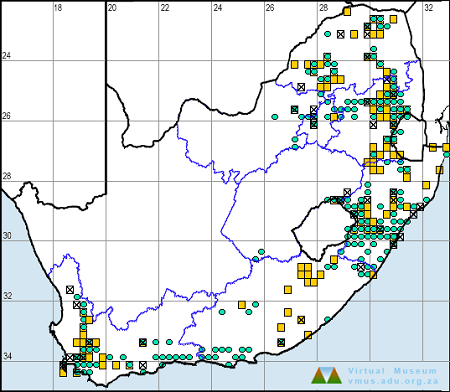Cover photo by Gerhard Diedericks.
Find the Rock Hooktail in the FBIS database (Freshwater Biodiversity Information System) here.
Family Gomphidae
Identification

Moordkuil River, Western Cape
Photo by Ryan Tippett
Medium sized
Length reaches 46mm; Wingspan attains 60mm.
The overall colour of both sexes is yellow with thick, brownish-black markings. In mature males some of the dark bands on the thorax develop a weak grey-blue pruinosity. Males are easily recognised by their dark-tipped upper claspers that splay outwards near the tip. Females are a bit duller and have broader abdomens that lack foliations and hooked claspers.
Individuals from higher rainfall areas tend to be darker in colour.

Near Kosi Bay, KwaZulu-Natal
Photo by Ryan Tippett
The Rock Hooktail is most similar to the Flapper Hooktail (Paragomphus sabicus) and Common Hooktail (Paragomphus genei). Paragomphus sabicus is larger and brighter yellow with slender, elongate upper claspers. Paragomphus genei is of similar size but has a green thorax and yellowish upper claspers, that do not curve outwards near the tip.
Click here for more details on identification of the Rock Hooktail.

Kosi Bay,iSimangaliso Wetland Park, KwaZulu-Natal
Photo by Ryan Tippett
Habitat
The Rock Hooktail occurs in a wide range of biomes in both open and more wooded environments, including, grassland, fynbos, savanna, and forest. It is confined to rock-strewn rivers and streams where they may be seen at river pools or on mid-stream rocks. Some individuals may also be found a short distance from the river on trees and bushes in the surrounding habitat. The Rock Hooktail is found from sea-level up to 2000m above sea level.

Photo by Alex Briggs
Behaviour
The Rock Hooktail is most often seen sitting prominently on rocks close to the water, but also occasionally sits on vegetation. They can sometimes be seen hunting from the tops of bushes or other vegetation. Non-breeding males and females are most often found away from the water. Females are encountered less frequently than males. The Rock Hooktail hunts from a perch, but quickly settles again. This species is on the wing from mid-September to May or early June in warmer areas (see Phenology below).

Ixopo district, KwaZulu-Natal
Photo by Ryan Tippett
Status and Conservation
The Rock Hooktail is a common species. It is listed as of least Concern in the IUCN Red List of Threatened species. The Rock Hooktail is a fairly hardy species but is nonetheless restricted to natural riverine habitat.

Seweweekspoort, Western Cape
Photo by Ryan Tippett
Distribution
Paragomphus cognatus is widespread and occurs in Southern and East Africa, ranging from the Western Cape in South Africa up to Kenya and Uganda in the North. It also occurs across South-central Africa to parts of Angola and northern Namibia.
In South Africa, the Rock Hooktail is widespread in the South and east but is largely absent from the central interior.
Below is a map showing the distribution of records for Rock Hooktail in the OdonataMAP database as at February 2020.

Below is a map showing the distribution of records for Rock Hooktail in the OdonataMAP database as at December 2024.

The next map below is an imputed map, produced by an interpolation algorithm, which attempts to generate a full distribution map from the partial information in the map above. This map will be improved by the submission of records to the OdonataMAP section of the Virtual Museum.


Ultimately, we will produce a series of maps for all the odonata species in the region. The current algorithm is a new algorithm. The objective is mainly to produce “smoothed” maps that could go into a field guide for odonata. This basic version of the algorithm (as mapped above) does not make use of “explanatory variables” (e.g. altitude, terrain roughness, presence of freshwater — we will be producing maps that take these variables into account soon). Currently, it only makes use of the OdonataMAP records for the species being mapped, as well as all the other records of all other species. The basic maps are “optimistic” and will generally show ranges to be larger than what they probably are.
Further Resources
The use of photographs by John Wilkinson, and Sharon Stanton is acknowledged. All other photographs by Ryan Tippett.
Rock Hooktail Paragomphus cognatus (Rambur, 1842)
Other Common Names: Boulder Hooktail (Alt. English); Kliphakiestert (Afrikaans).
Recommended citation format: Loftie-Eaton M; Navarro R; Tippett RM; Underhill L. 2025. Rock Hooktail Paragomphus cognatus. Biodiversity and Development Institute. Available online at https://thebdi.org/2020/06/01/rock-hooktail-paragomphus-cognatus/
References: Tarboton, M; Tarboton, W. (2019). A Guide to the Dragonflies & Damselflies of South Africa. Struik Nature.
Samways, MJ. (2008). Dragonflies and Damselflies of South Africa. Pensoft
Samways, MJ. (2016). Manual of Freshwater Assessment for South Africa: Dragonfly Biotic Index. Suricata 2. South African National Biodiversity Institute, Pretoria
Martens, A; Suhling, F. (2007). Dragonflies and Damselflies of Namibia. Gamsberg Macmillan.

Vanrhynsdorp Waterfall, Western Cape
Photo by Ryan Tippett

